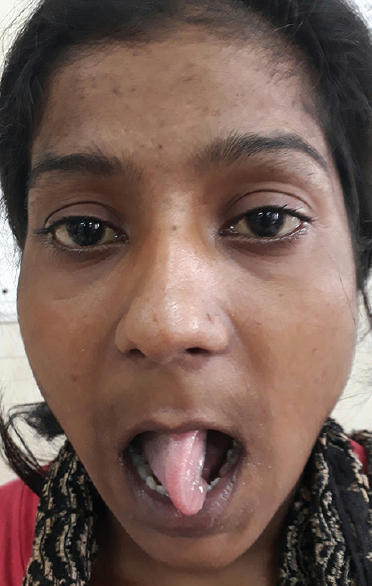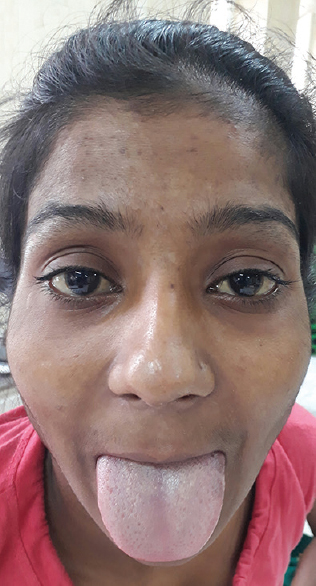Translate this page into:
Isolated Lingual Dystonia as the Manifestation of Acute Extrapyramidal Syndrome Induced by Metoclopramide
Address for correspondence: Prof. Rajesh Verma, Department of Neurology, King George's Medical University, Lucknow - 226 003, Uttar Pradesh, India. E-mail: drrajeshverma32@yahoo.com
This is an open access journal, and articles are distributed under the terms of the Creative Commons Attribution-NonCommercial-ShareAlike 4.0 License, which allows others to remix, tweak, and build upon the work non-commercially, as long as appropriate credit is given and the new creations are licensed under the identical terms.
This article was originally published by Wolters Kluwer - Medknow and was migrated to Scientific Scholar after the change of Publisher.
Abstract
Oromandibular dystonia is characterized by persistent contractions and repetitive spasms of masticatory muscles surrounding the oral cavity and lingual muscles. The lingual dystonia is rare hyperkinetic movement disorder, often occurring secondary to drugs. The common drugs which can cause acute focal dystonia are neuroleptics, antiemetics, and antipsychotics. Isolated lingual dystonia is a rare form of disabling focal dystonias. We report a young female, who developed tongue dystonia in isolation and responding favorably to antihistaminics. The physicians are advised to make inquiry about administered drugs in isolated lingual dystonia.
Keywords
Abnormal postures
antiemetics
focal dystonia
metoclopramide
muscle contractions
oromandibular dystonia
INTRODUCTION
Dystonia can be defined as adoption of abnormal postures, repetitive spasms occurring due to sustained muscle contractions. According to the site, it can be classified into focal, multifocal, and generalized dystonia.[1] The dystonia has been classified on different scales, which include mode of onset, site of body, drug induced, and with the presence of additional neurological and other systemic features.[2] The acute dystonia is mainly caused by drugs and toxins. The drugs commonly implicated in acute dystonic reactions belong to category of neuroleptics, antiemetics, antiepileptics, and antipsychotics.[3] In this case report, we intended to present a young female, who developed isolated lingual dystonia as the manifestation of metoclopramide therapy. The literature is scant about the manifestation of drug-induced lingual dystonia. The patient remarkably responded to anticholinergics and diphenhydramine therapy.
CASE REPORT
An 18-year-old female presented with abnormal posturing of the tongue for 5 days [Figure 1]. Due to the abnormal and persistent position of the tongue, she was having difficulty in speech. The patient was previously asymptomatic 5 days ago when she developed fever and vomiting. For these symptoms, she consulted a doctor who prescribed antipyretics and antiemetics.

- Patient photograph demonstrating vertical sustained posture of the tongue (lingual dystonia)
Within 24 h, she developed abnormal posturing of the tongue. It was characterized by vertical positioning of the tongue. It was not episodic. It was associated with severe dysarthria and difficulty in swallowing. The history was negative of dystonic postures in any other location of the body. She negated about the presence of difficulty in opening or closure of the mouth, spasm of the eyelid, or persistent abnormal neck postures.
There was no history of seizures, jaundice, psychiatric illness, or history suggestive of endocrinal abnormality. The oral examination revealed persistent, vertical posturing of the tongue [Video 1]. There was difficulty in protrusion and sideways movement of the tongue. The cognition, motor system, sensory examination, reflexes, and cerebellum were unremarkable. There was no evidence of dystonia involving any other body part. Slit lamp examination did not reveal Kayser–Fleischer ring.
Her blood investigations revealed normal hematological parameters. Her serum electrolytes including sodium/potassium were within normal limits. Other biochemical parameters including liver function test, renal assessment, thyroid function test, and calcium/phosphorus levels did not show any abnormality. Her creatine phosphokinase level was within normal range. The cerebrospinal fluid analysis was done, and it showed normal cellularity and biochemical indices. Cerebral spinal fluid virology did not suggest any viral infection including Japanese encephalitis virus. The serology was negative for common viruses. The electroencephalography showed normal rhythms. Computerized tomography of the cranium does not exhibit any abnormality.
Following admission, the patient was given a stat dose of injection promethazine and started with tablet trihexyphenidyl 2 mg thrice daily. Within 24 h, there was gradual improvement in the dystonic posturing which normalized within 3 days [Figure 2].

- Normal tongue movement after treatment
The patient was discharged with symptomatic medications and discharged in a stable condition.
DISCUSSION
Dystonia has been characterized by persistent or intermittent muscular contractions, resulting in patterned abnormal repetitive movements and unexpected postures and can be accompanied by tremors. The focal dystonia is a subtype of dystonias, which manifested in specific regions of the body.[4] The oromandibular dystonia is one of the well-known varieties of focal dystonia. The oromandibular dystonia is a specific type of focal disorder affecting the muscles of the lower facial region. It results from sustained, repetitive contractions of the tongue, chewing, and other lower facial muscles. It is caused by different types of pathologies mainly vascular, infective, toxins, drugs, and degenerative clinical disorders.[5]
Various drugs are known to cause acute extrapyramidal syndrome. The drugs which lead to dopamine receptor stimulation and dopamine blocking effects are culprits for acute extrapyramidal reactions. Neuroleptics, antiepileptics, antipsychotics, antihypertensives, anesthethics, and antiemetics are offending agents for causing acute extrapyramidal syndromes.[6]
The extrapyramidal reactions are rarely reported after administration of anesthetic agents. Propofol is well-recognized agent to cause different types of hyperkinetic features which comprise ballismus, dystonia, chorea, and even opisthotonus. A case was reported of 17-year-old male suffering from ulcerative colitis, who presented with torticollis, tongue thrusting movements, and oculogyric crisis after administration of propofol. The patient responded instantaneously to diphenhydramine.[7]
Our patient had a history of fever accompanied by vomiting, for which she was administered antiemetic agent. She developed lingual dystonia and had persistent abnormal vertical posture which was well evident on opening of the mouth. The author reported a case of self-injured tongue dystonia due to perinatal stroke.[8] Metoclopramide is a common drug used by physicians to treat nausea and vomiting. The antiemetic effect is subserved by inhibiting chemoreceptor trigger zone and area postrema in medulla oblongata due to blockade of dopamine receptors.[9] The acute dystonic reactions occur due to concomitant blocking of dopamine receptors (D2) in basal ganglia.[10]
A young female developed twisting movements of the tongue and deviated jaw after consumption of 40 mg of metoclopramide for the alleviation of abdominal pain and vomiting. She responded well to antihistaminics. The extrapyramidal side effects due to metoclopramide are harmless and reversible, provided treatment is offered emergently.[11]
Other drugs causing lingual/oromandibular dystonia reported in the literature are olanzapine, anticancer drug capecitabine, risperidone, aripiprazole, cyclizine, meperidine, cisapride, and pimozide. The oromandibular dystonia described with these drugs occurred in different clinical settings.[12] Rarely, acute dystonic reactions could happen with underlying neurodegenerative parkinsonism. The author reported a 53-year-old female, diagnosed as case of dementia with Lewy bodies who developed subacute onset severe lingual dystonia. It was proposed that dystonia was provoked by antiparkinson drugs due to stimulation of dopamine D1 receptors.[13]
Isolated lingual dystonia as manifestation of drugs has not been reported in the literature. In few cases mentioned in the literature, the lingual dystonia was accompanied by other involved areas. The treatment of acute dystonic reactions induced by drugs is well controlled by antihistaminics and anticholinergics. In some patients of intractable lingual dystonia, botulinum toxin therapy was instituted with successful results.[14]
Declaration of patient consent
The authors certify that they have obtained all appropriate patient consent forms. In the form, the patient has given her consent for her image and other clinical information to be reported in the journal. The patient understands that her name and initial will not be published and due efforts will be made to conceal their identity, but anonymity cannot be guaranteed.
Financial support and sponsorship
Nil.
Conflicts of interest
There are no conflicts of interest.
Video Available on: www.ruralneuropractice.com
REFERENCES
- Phenomenology and classification of dystonia: A consensus update. Mov Disord. 2013;28:863-73.
- [Google Scholar]
- Sethi KD, ed. Drug-Induced Movement Disorders. New York: Marcel Dekker; 2003.
- The focal dystonias: Current views and challenges for future research. Mov Disord. 2013;28:926-43.
- [Google Scholar]
- Oromandibular dystonia: Differential diagnosis and management. J Am Dent Assoc. 2015;146:690-3.
- [Google Scholar]
- Drug-induced extrapyramidal syndromes: Implications for contemporary practice. Psychiatr Clin North Am. 2016;39:391-411.
- [Google Scholar]
- Diphenhydramine for acute extrapyramidal symptoms after propofol administration. Pediatrics. 2017;139 pii: e20161135
- [Google Scholar]
- Case report of a severe recurrent tongue self-injury in an infant with dystonia. Pediatrics. 2016;138 pii: e20160738
- [Google Scholar]
- Metoclopramide-induced acute dystonic reaction: A case report. Eurasian J Med. 2013;45:58-9.
- [Google Scholar]
- Extrapyramidal reactions with metoclopramide. Br Med J (Clin Res Ed). 1985;291:930-2.
- [Google Scholar]
- Metoclopramide induced acute dystonic reaction: A case report. BMC Res Notes. 2017;10:32.
- [Google Scholar]
- Medication-induced acute dystonic reaction: The challenge of diagnosing movement disorders in the intensive care unit. BMJ Case Rep 2015 2015 pii: bcr2014207215
- [Google Scholar]
- Dementia with lewy bodies presenting marked tongue protrusion and bite due to lingual dystonia: A case report. Rinsho Shinkeigaku. 2016;56:418-23.
- [Google Scholar]
- Lingual protrusion dystonia: Frequency, etiology and botulinum toxin therapy. Parkinsonism Relat Disord. 2010;16:438-41.
- [Google Scholar]






